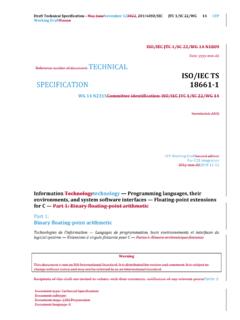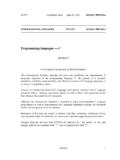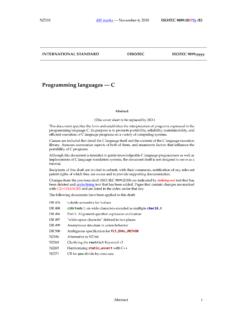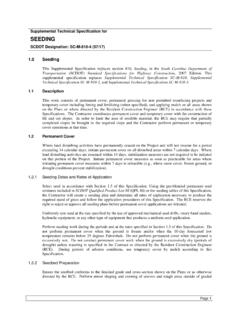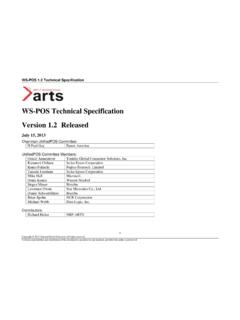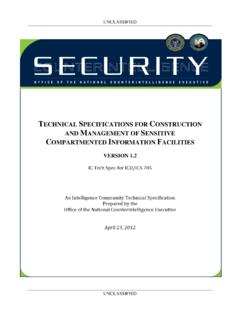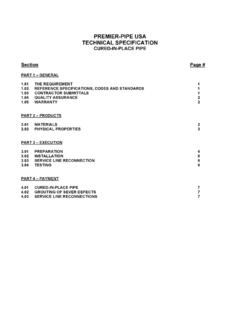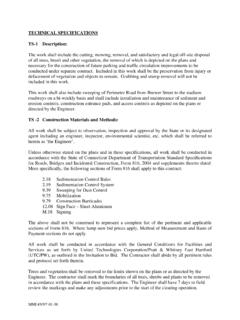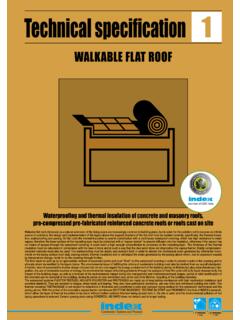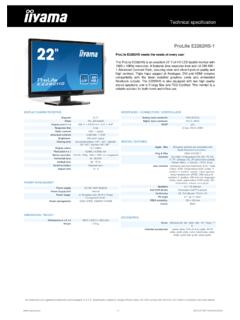Transcription of TECHNICAL ISO/IEC TS SPECIFICATION 18661-1 - open-std.org
1 Draft TECHNICAL SPECIFICATION November 12, 2018 ISO/IEC JTC 1/SC 22/WG 14 CFP Working Draft TECHNICAL ISO/IEC TS SPECIFICATION 18661-1 WG 14 N2314 CFP Working Draft For C2X integration 2018-11-12 Information technology Programming languages, their environments, and system software interfaces Floating-point extensions for C Part 1: Binary floating-point arithmetic Technologies de l information Langages de programmation, leurs environnements et interfaces du logiciel syst me Extensions virgule flottante pour C Partie 1: Binaire arithm tique flottante Reference number ISO/IEC TS 18661-1 :2014(E) ISO/IEC 2016 ISO/IEC TS 18661-1 :CFP Working Draft ii ISO/IEC 2016 All rights reserved 5 ISO/IEC 2016 10 All rights reserved. Unless otherwise specified, no part of this publication may be reproduced or utilized otherwise in any form or by any means, electronic or mechanical, including photocopying, or posting on the internet or an intranet, without prior written permission.
2 Permission can be requested from either ISO at the address below or ISO s member body in the country of the requester. 15 ISO copyright office Case postale 56 CH-1211 Geneva 20 Tel. + 41 22 749 01 11 Fax + 41 22 749 09 47 E-mail Web COPYRIGHT PROTECTED DOCUMENT ISO/IEC TS 18661-1 :CFP Working Draft ISO/IEC 2016 All rights reserved iii Published in Switzerland Foreword .. v Introduction .. vi 1 Scope .. 1 2 Conformance .. 1 5 3 Normative references .. 1 4 Terms and definitions .. 1 5 C standard conformance .. 2 Freestanding implementations .. 2 Predefined 2 10 Standard headers .. 3 6 Revised floating-point standard .. 5 7 Types .. 6 Terminology .. 6 Canonical representation .. 7 15 8 Operation binding .. 9 9 Floating to integer conversion .. 14 10 Conversions between floating types and character sequences .. 15 Conversions with decimal character sequences .. 15 Conversions to character sequences.
3 16 20 11 Constant rounding directions .. 17 12 NaN support .. 24 13 Integer width macros .. 30 14 Mathematics < > .. 32 Nearest integer functions .. 32 25 Round to integer value in floating type .. 32 Convert to integer 35 The llogb functions .. 37 Max-min magnitude functions .. 38 The nextup and nextdown functions .. 40 30 Functions that round result to narrower type .. 41 Comparison macros .. 45 Classification macros .. 46 Total order functions .. 48 Canonicalize functions .. 49 35 NaN functions .. 51 15 The floating-point environment < > .. 52 The fesetexcept function .. 52 The fetestexceptflag function .. 53 Control modes .. 54 40 16 Type-generic math < > .. 55 Bibliography .. 58 ISO/IEC TS 18661-1 :CFP Working Draft iv ISO/IEC 2016 All rights reserved ISO/IEC TS 18661-1 :CFP Working Draft ISO/IEC 2016 All rights reserved v Foreword ISO (the International Organization for Standardization) and IEC (the International Electrotechnical Commission) form the specialized system for worldwide standardization.
4 National bodies that are members of ISO or IEC participate in the development of International Standards through TECHNICAL committees established by the respective organization to deal with particular fields of TECHNICAL activity. 5 ISO and IEC TECHNICAL committees collaborate in fields of mutual interest. Other international organizations, governmental and non-governmental, in liaison with ISO and IEC, also take part in the work. In the field of information technology, ISO and IEC have established a joint TECHNICAL committee, ISO/IEC JTC 1. The procedures used to develop this document and those intended for its further maintenance are 10 described in the ISO/IEC Directives, Part 1. In particular the different approval criteria needed for the different types of document should be noted. This document was drafted in accordance with the editorial rules of the ISO/IEC Directives, Part 2 (see ).
5 Attention is drawn to the possibility that some of the elements of this document may be the subject of patent rights. ISO and IEC shall not be held responsible for identifying any or all such patent rights. 15 Details of any patent rights identified during the development of the document will be in the Introduction and/or on the ISO list of patent declarations received (see ). Any trade name used in this document is information given for the convenience of users and does not constitute an endorsement. For an explanation on the meaning of ISO specific terms and expressions related to conformity 20 assessment, as well as information about ISO's adherence to the WTO principles in the TECHNICAL Barriers to Trade (TBT) see the following URL: Foreword - Supplementary information The committee responsible for this document is ISO/IEC JTC 1, Information technology, Subcommittee SC 22, Programming languages, their environments, and system software interfaces.
6 ISO/IEC TS 18661 consists of the following parts, under the general title Information technology 25 Programming languages, their environments, and system software interfaces Floating-point extensions for C: Part 1: Binary floating-point arithmetic Part 2: Decimal floating-point arithmetic Part 3: Interchange and extended types 30 Part 4: Supplementary functions Part 5: Supplementary attributes ISO/IEC TS 18661-1 updates ISO/IEC 9899:2011, Information technology Programming Language C, annex F in particular, to support all required features of ISO/IEC /IEEE 60559:2011, Information technology Microprocessor Systems Floating-point arithmetic. 35 ISO/IEC TS 18661-2 supersedes ISO/IEC TR 24732:2009, Information technology Programming languages, their environments and system software interfaces Extension for the programming language C to support decimal floating-point arithmetic.
7 ISO/IEC TS 18661-3, ISO/IEC TS 18661-4, and ISO/IEC TS 18661-5 specify extensions to ISO/IEC 9899:2011 for features recommended in ISO/IEC /IEEE 60559 ISO/IEC TS 18661-1 :CFP Working Draft vi ISO/IEC 2016 All rights reserved Introduction Background IEC 60559 floating-point standard The IEEE 754-1985 standard for binary floating-point arithmetic was motivated by an expanding diversity in floating-point data representation and arithmetic, which made writing robust programs, 5 debugging, and moving programs between systems exceedingly difficult. Now the great majority of systems provide data formats and arithmetic operations according to this standard. The IEC 60559:1989 international standard was equivalent to the IEEE 754-1985 standard. Its stated goals were the following: 1 Facilitate movement of existing programs from diverse computers to those that adhere to 10 this standard.
8 2 Enhance the capabilities and safety available to programmers who, though not expert in numerical methods, may well be attempting to produce numerically sophisticated programs. However, we recognize that utility and safety are sometimes antagonists. 3 Encourage experts to develop and distribute robust and efficient numerical programs that 15 are portable, by way of minor editing and recompilation, onto any computer that conforms to this standard and possesses adequate capacity. When restricted to a declared subset of the standard, these programs should produce identical results on all conforming systems. 4 Provide direct support for a. Execution-time diagnosis of anomalies 20 b. Smoother handling of exceptions c. Interval arithmetic at a reasonable cost 5 Provide for development of a. Standard elementary functions such as exp and cos b. Very high precision (multiword) arithmetic 25 c. Coupling of numerical and symbolic algebraic computation 6 Enable rather than preclude further refinements and extensions.
9 To these ends, the standard specified a floating-point model comprising the following: formats for binary floating-point data, including representations for Not-a-Number (NaN) and signed infinities and zeros 30 operations basic arithmetic operations (addition, multiplication, etc.) on the format data to compose a well-defined, closed arithmetic system; also specified conversions between floating-point formats and decimal character sequences, and a few auxiliary operations context status flags for detecting exceptional conditions (invalid operation, division by zero, overflow, underflow, and inexact) and controls for choosing different rounding methods 35 ISO/IEC TS 18661-1 :CFP Working Draft ISO/IEC 2016 All rights reserved vii The ISO/IEC /IEEE 60559:2011 international standard is equivalent to the IEEE 754-2008 standard for floating-point arithmetic, which is a major revision to IEEE 754-1985.
10 The revised standard specifies more formats, including decimal as well as binary. It adds a 128-bit binary format to its basic formats. It defines extended formats for all of its basic formats. It specifies data interchange formats (which may or may not be arithmetic), including a 16-bit binary format and an 5 unbounded tower of wider formats. To conform to the floating-point standard, an implementation must provide at least one of the basic formats, along with the required operations. The revised standard specifies more operations. New requirements include among others arithmetic operations that round their result to a narrower format than the operands (with just one rounding), more conversions with integer types, more classifications and comparisons, and more operations for 10 managing flags and modes. New recommendations include an extensive set of mathematical functions and seven reduction functions for sums and scaled products.
